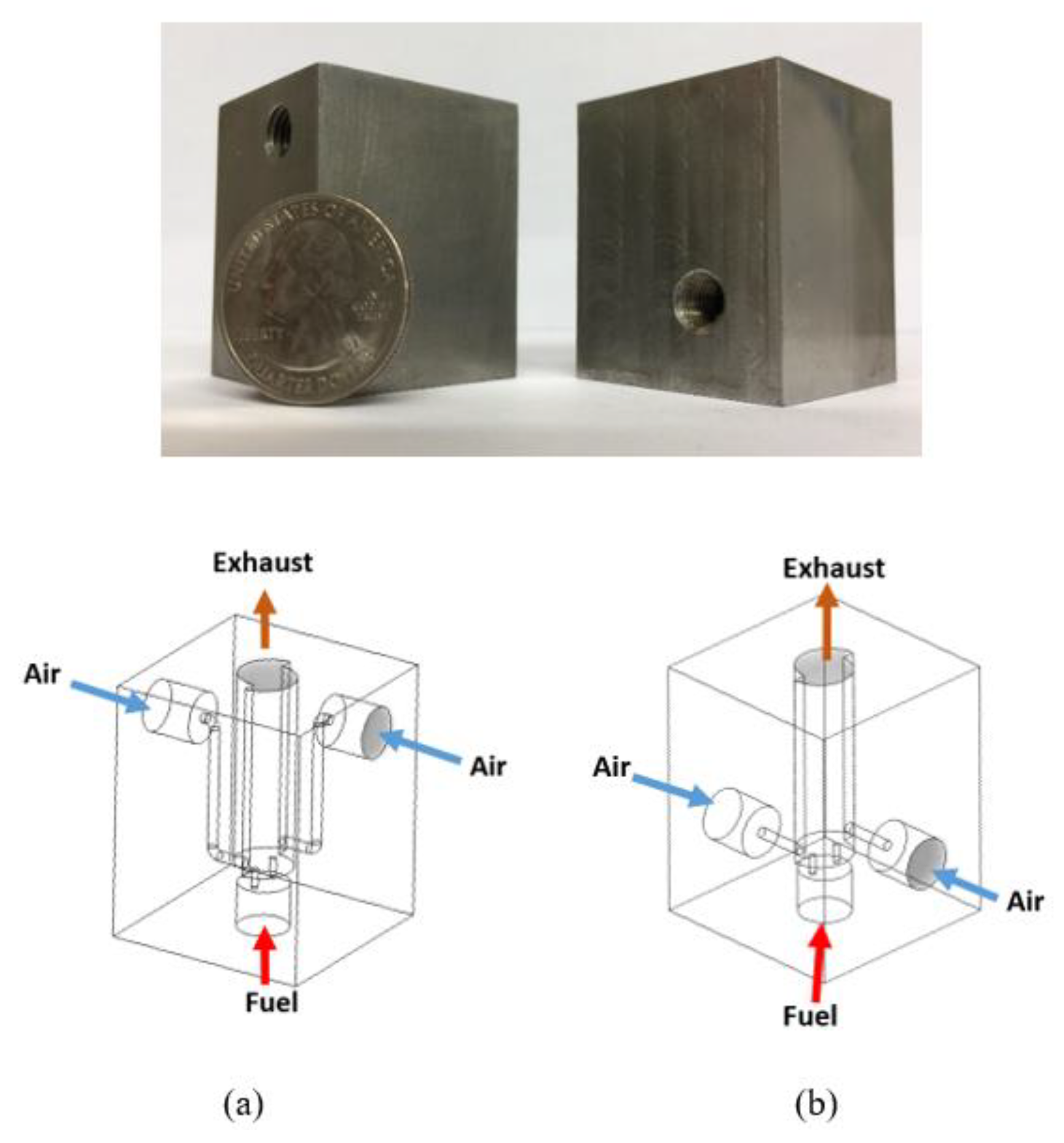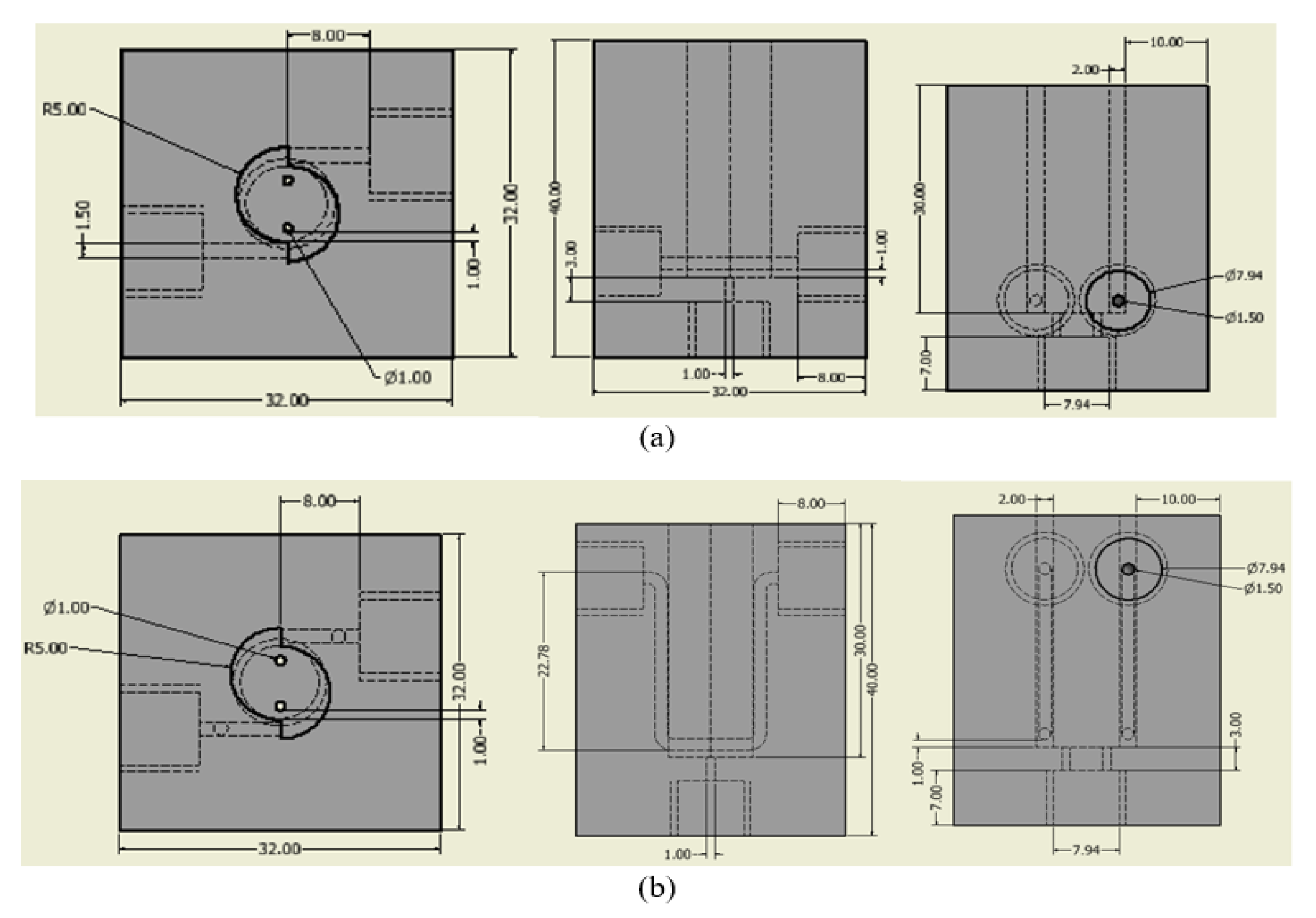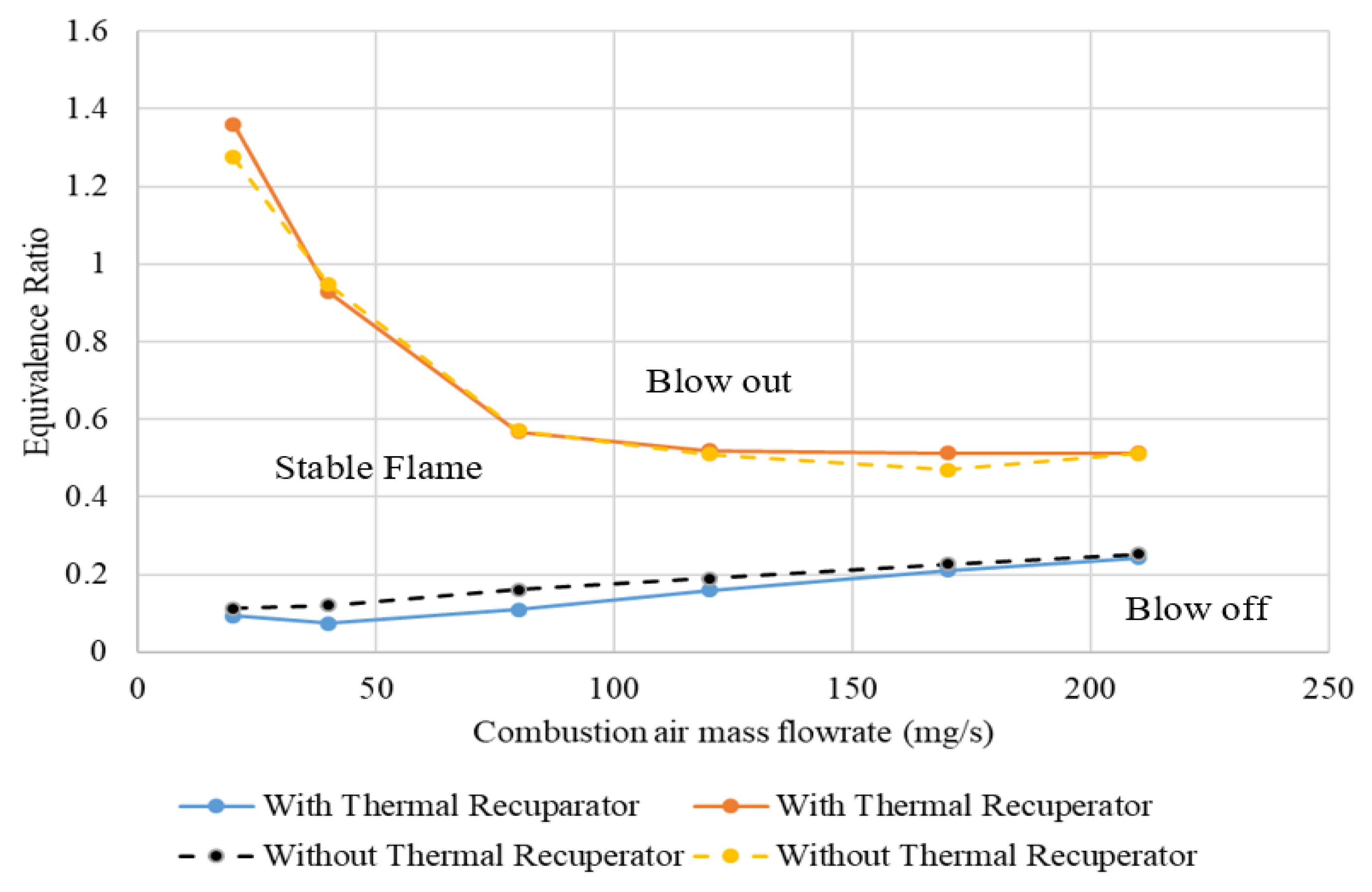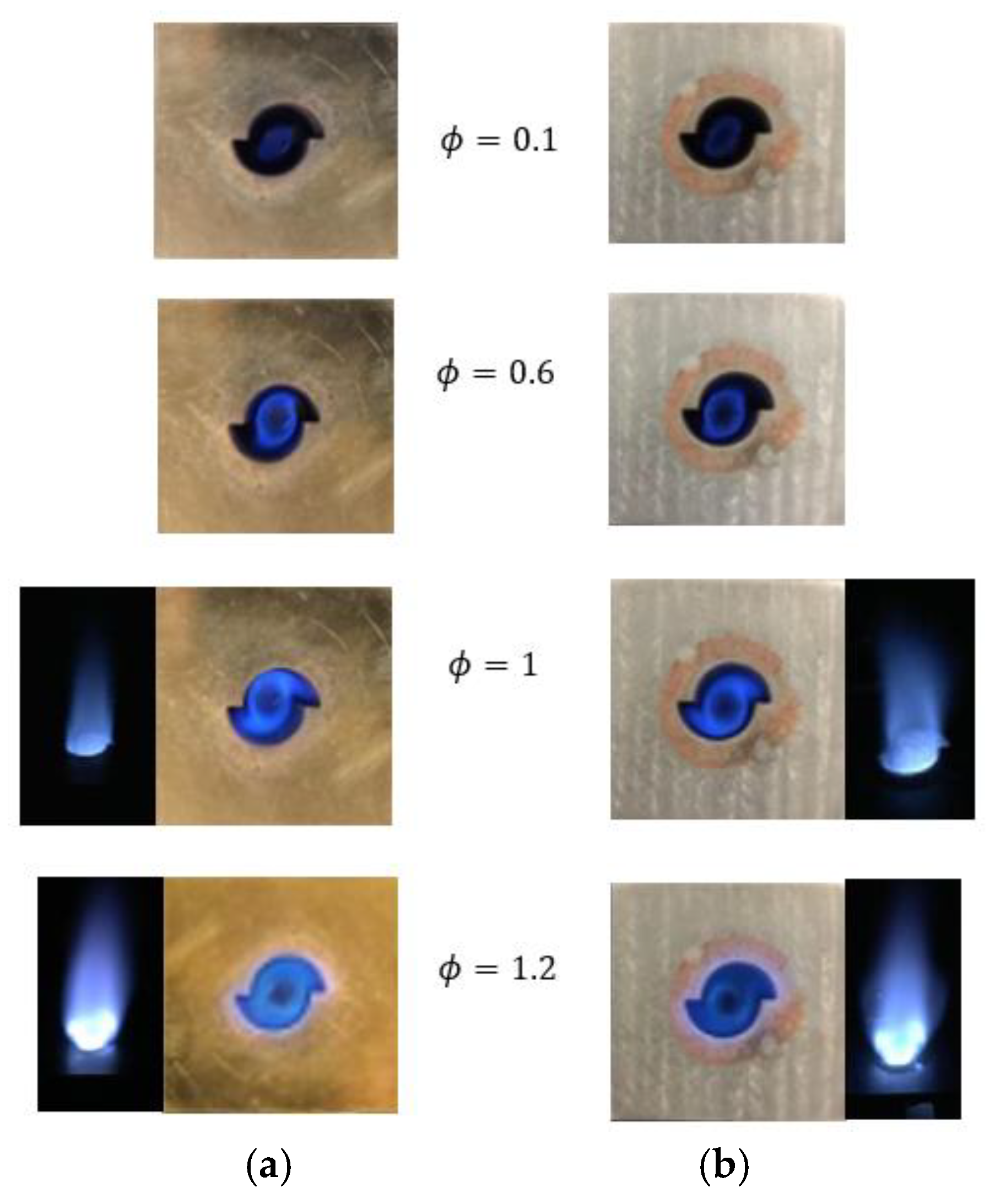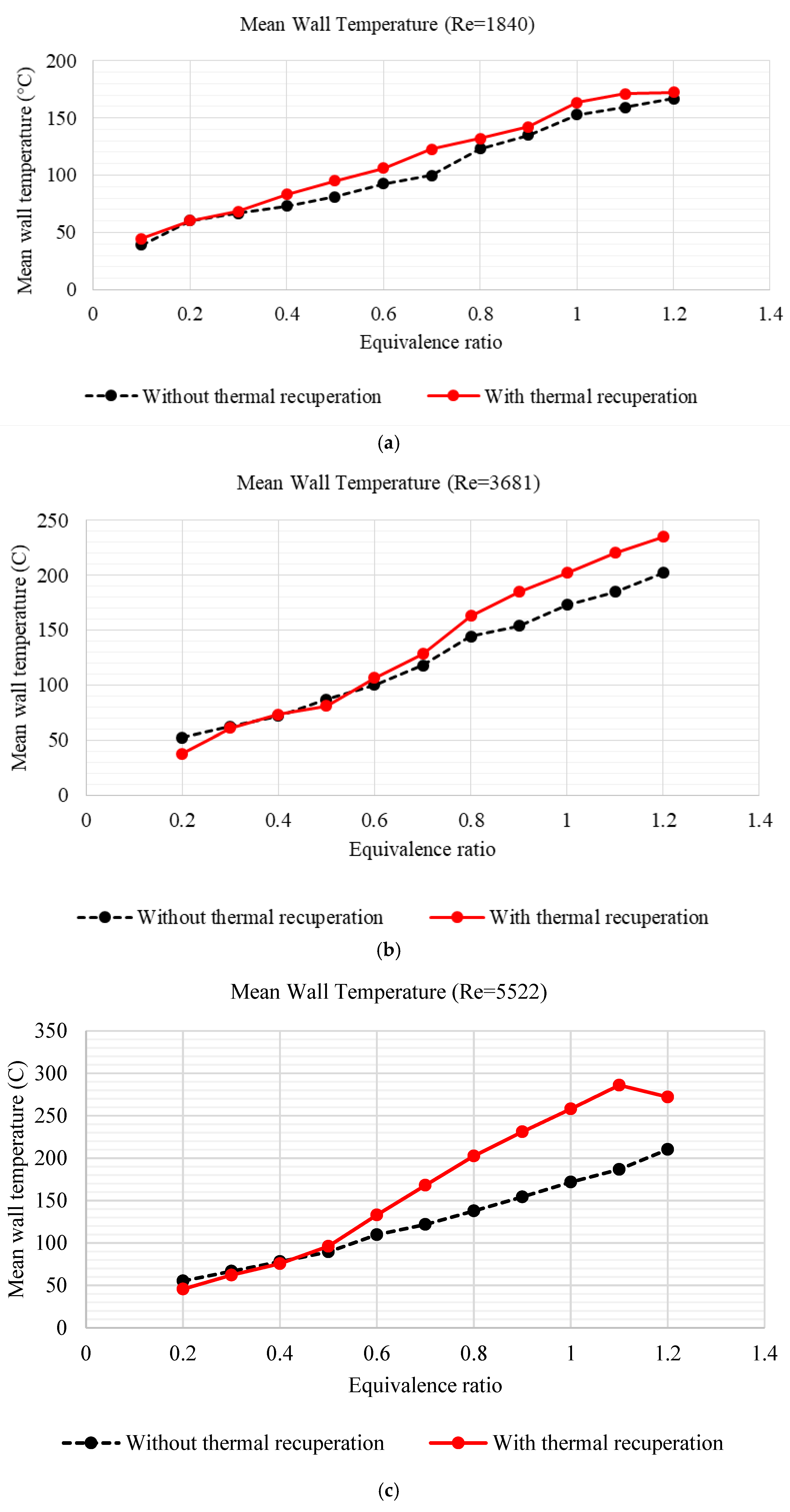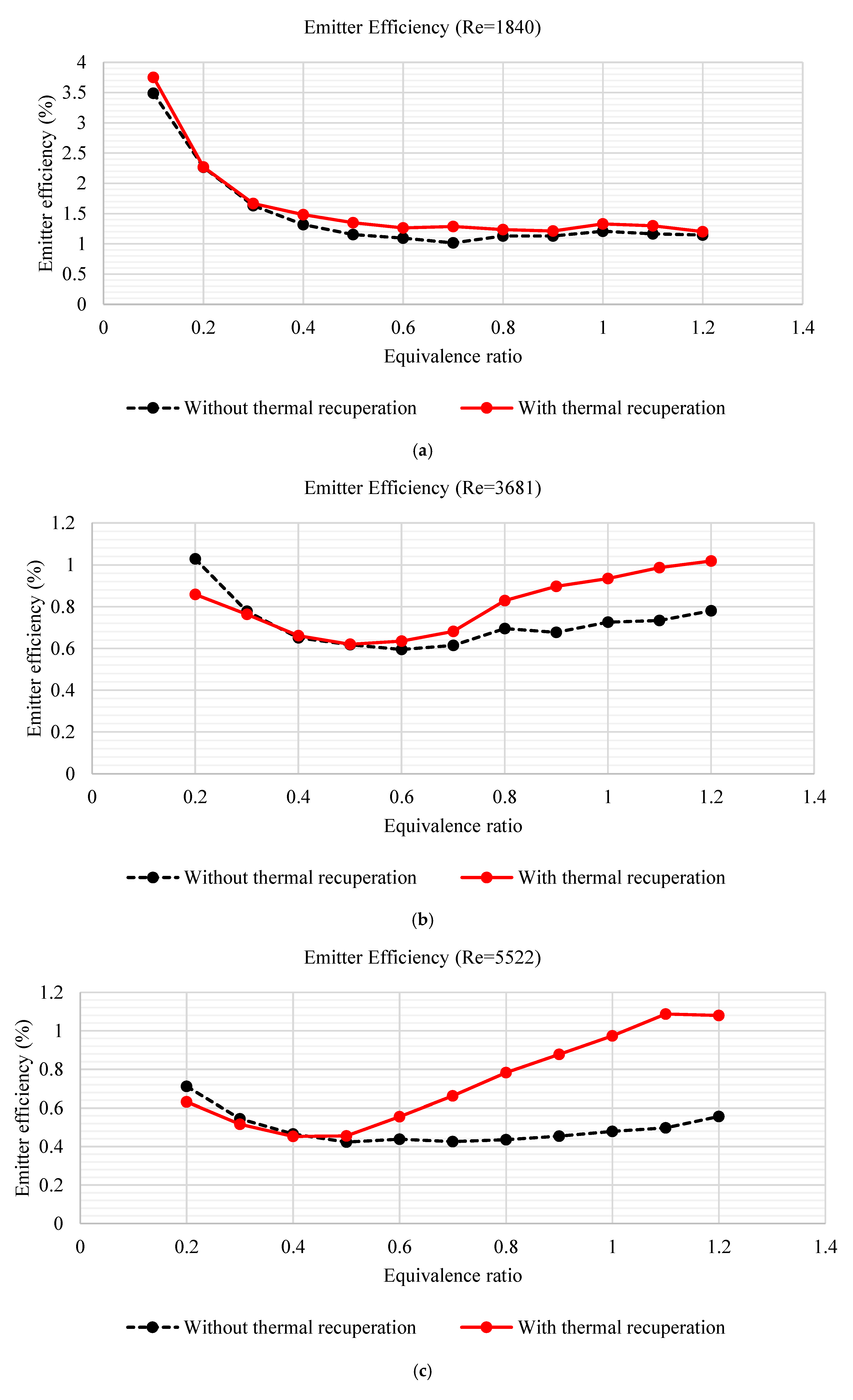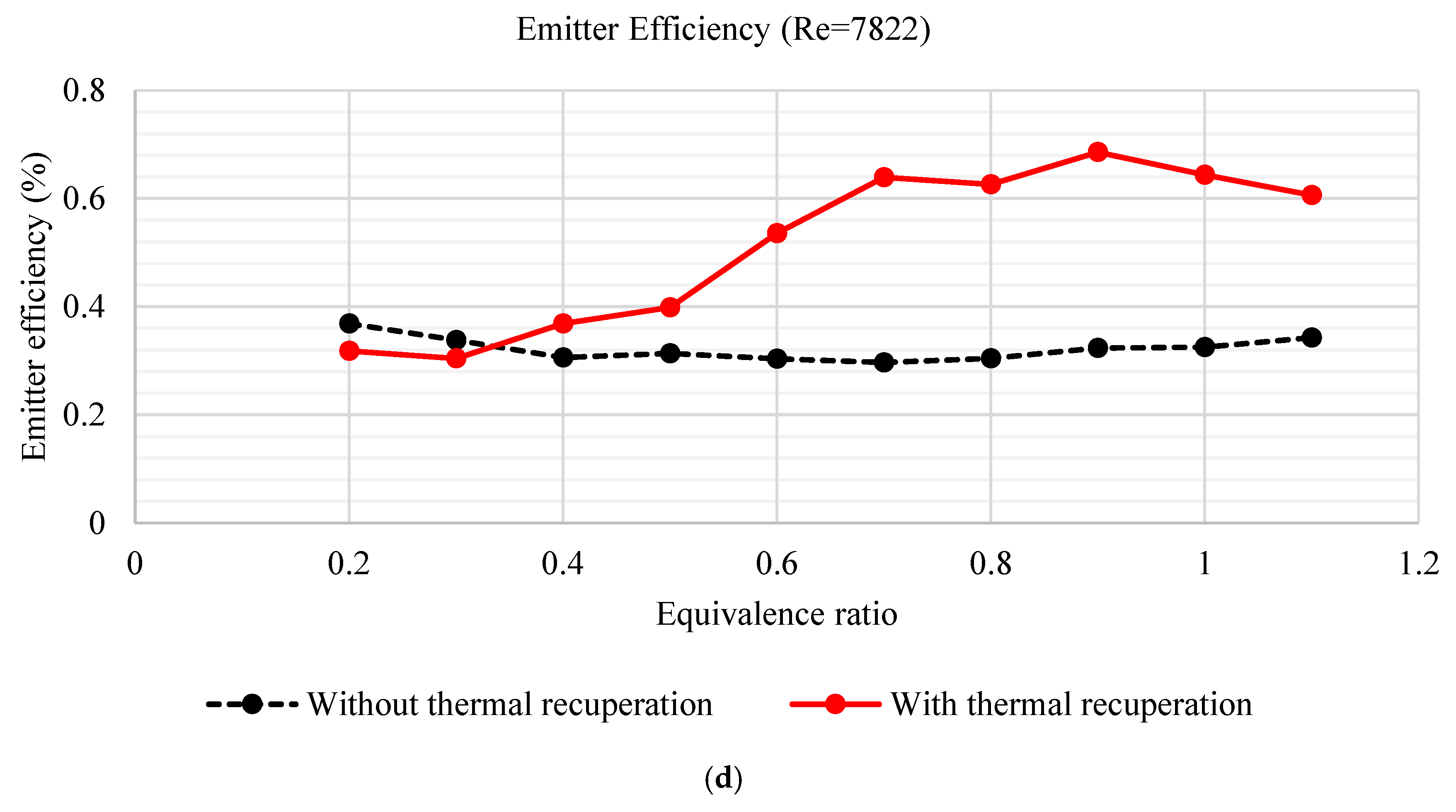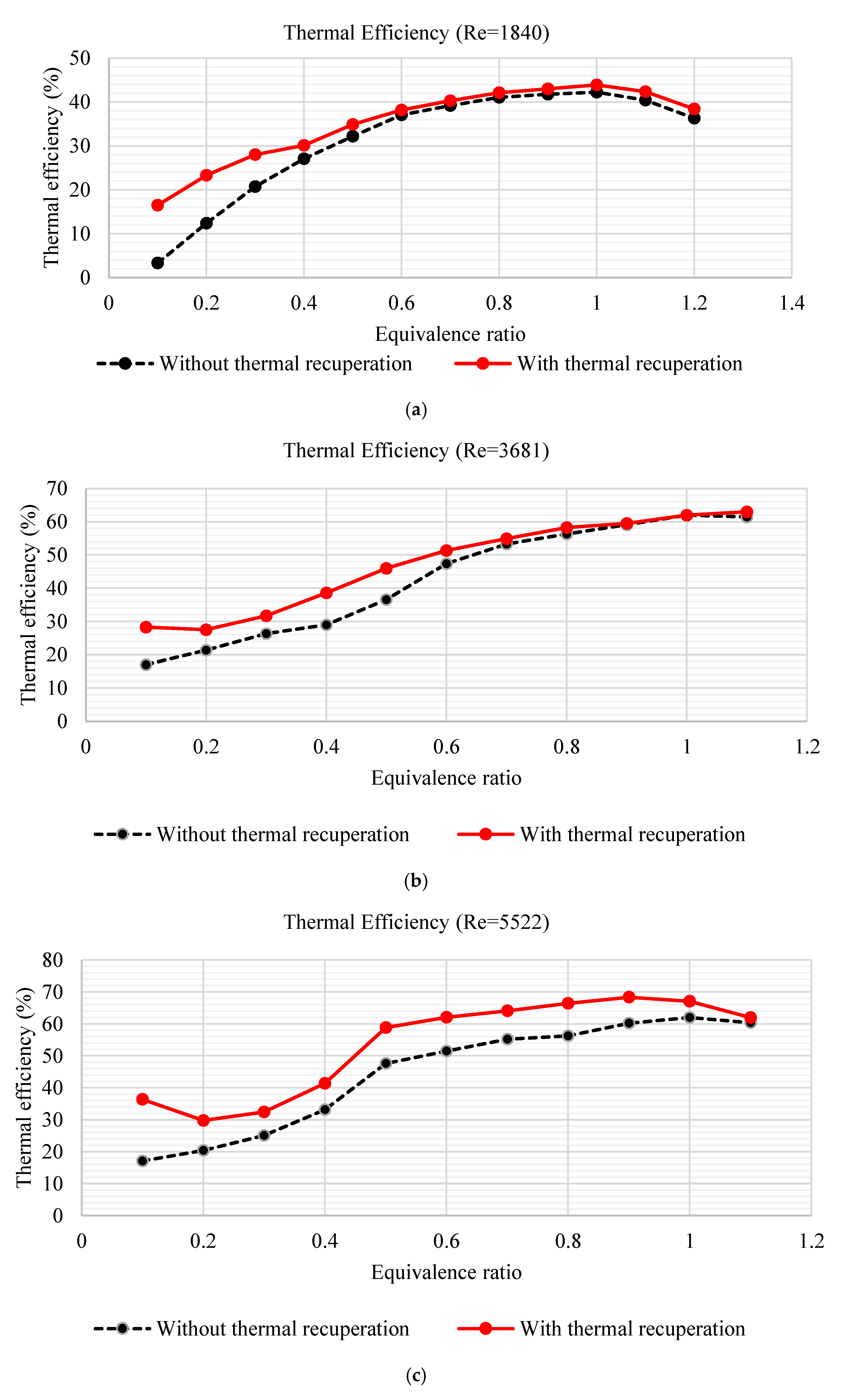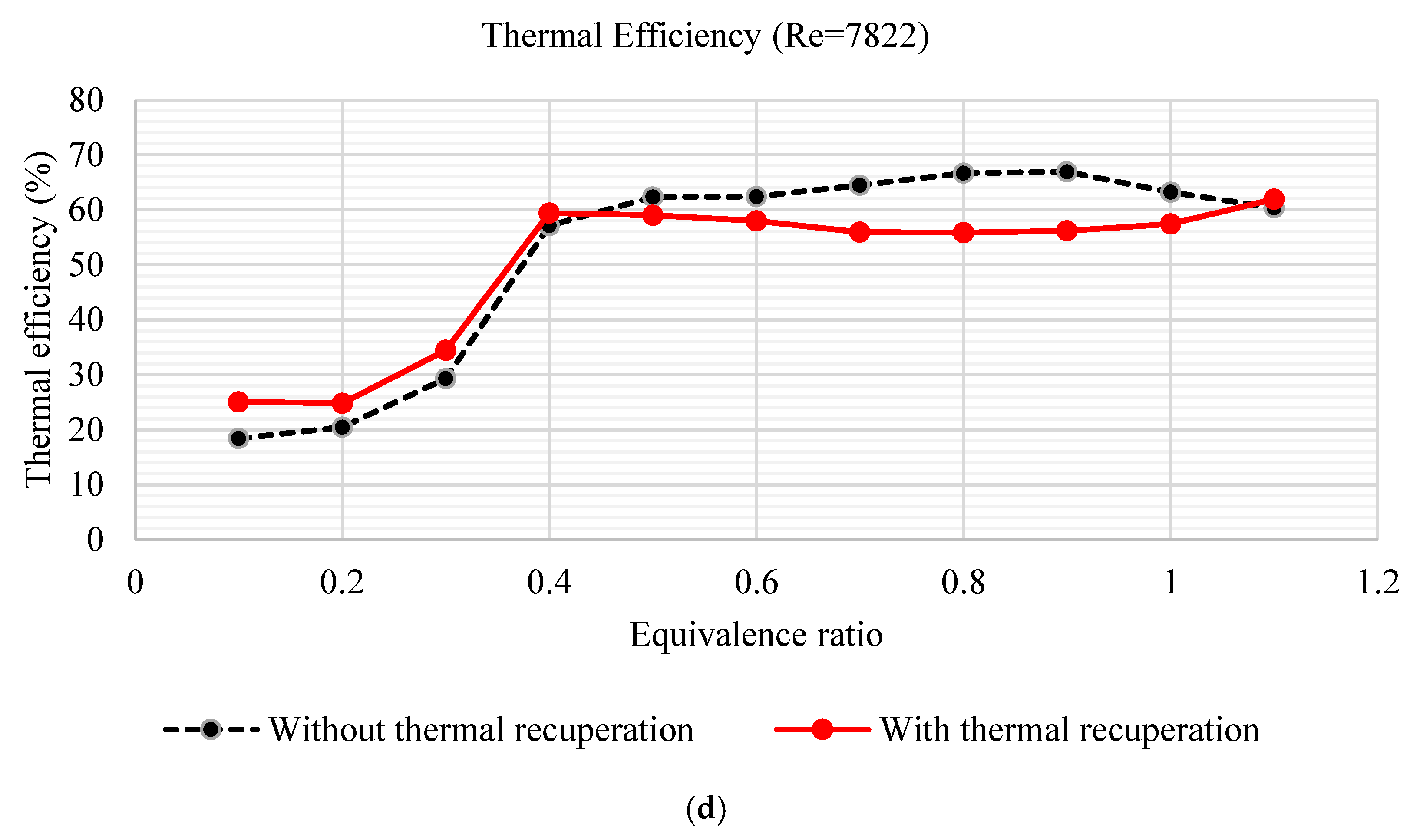1. Introduction
Investigations about small-scale combustion systems have been developed in recent years due to the progress in the miniaturization of electric power generation for running low weight mechanical devices (micro-pumps/motors/airplanes/rovers). Considering efficient energy conversion of small-scale combustion systems, application of these devices instead of current traditional batteries would result in weight reduction and lifetime augmentation of the mechanical systems [
1]. The functionality of portable micro-electro-mechanic-systems (MEMS) will be significantly improved by availability of high-performance small-scale power generators. Nevertheless, improvements in thermal and chemical management and proper diagnostic and control of the system would illustrate significant progress in the development of miniaturized combustion [
2]. The increasing requests to reduce system weight, mitigate system cost and enhance unit operational lifetimes have encouraged MEMS investigators to study about various concepts behind of this new field [
3]. One of the most important challenges in this new field is employing the high-specific energy of hydrocarbons in small-scale combustors to generate micro-power [
4]. Since the transportation of liquid hydrocarbon fuels is easy and quite safe and they have significantly high-specific energy (averagely 45 MJ/kg), they have been considered as the most important types of fuel for combustion-based micro-power generation [
5].
In a meso-scale combustor, the time scale of heat transfer in the walls becomes comparable to the time scale of combustion due to the size reduction. Therefore, the temperature difference between the flame and structure decreases, leading to a condition that both normal flame and weak flame exist. By increasing the combustor’s wall temperature, the ignition time becomes shorter, approaches the flow residence time and flame instability take places [
6]. The variations in combustor’s wall temperature has significant impacts on the meso-scale combustion when the Biot number (the ratio of diffusion time scale to the radiative and convective heat loss time scale) is not large. Moreover, the ratio of combustion time scale to the diffusion time scale in solid phase (Fourier number) plays an important role on the temperature distribution of wall temperature. In high Fourier numbers, the temperature distribution in the wall is considered quasi-steady-state. In miniaturized combustors, where the Knudsen number (the ratio of the molecular mean free path length to a representative physical length scale) is larger than 0.01, the non-equilibrium transport influences on the ignition and extinction [
7].
Since the ratio of area to volume increases in small-scale combustors, heat loss from the combustor’s wall enhances drastically and flame quenching occurs because the combustor’s wall acts like enthalpy sink and the heat of combustion cannot provide the heat loss to the surroundings through the wall [
8]. Furthermore, inadequate residence time and stabilization of flame in small-scale combustor is another important issue in this field. Several solutions have been suggested to enhance flame stability and mitigate quenching limits as follow:
Using inert porous media based on the concepts of heat transfer mechanisms and excess enthalpy where the solid porous medium is convectively heated by the flame and the heat is transferred upstream to preheat the inert mixture through radiation and conduction heat transfer [
9].
Catalytic combustion was proposed to enhance extinction limits, where the characteristic time scale of combustion is reduced in the presence of a catalytic surface [
10].
Vortex combustion was employed to stabilize flame in miniaturized combustor where a stable flame is achieved by a large, relatively quiescent, hot core flow which is formed by the recirculation of the flow along the chamber length [
11].
Recirculating heat to redistribute thermal energy within the chamber and minimize the heat loss to the surroundings [
12].
The rate of heat release depends on both Reynolds number and equivalence ratio, as it has proportional relation by the mass of fuel consumed [
13]. Increasing flammability in small-scale combustors has conducted the combustion researches to the heat recirculating systems. Investigations indicate the design of the small-scale combustor, as well as the walls of combustor have significant impacts on the flame dynamics, flame structure and its location [
14]. To develop combustion-based micro-power generation devices, the Swiss-roll approach was developed to indirectly recirculate burned gas energy to the unburned fuel/air mixture in the combustor [
15]. Kim et al. [
12] pointed out when the heat loss in a miniature Swiss-roll combustor increases (due to different combustor materials), the flammability of the mixture becomes narrower. Chen and Buckmaster [
16] stipulated when equivalence ratio or Reynolds number increases in a microscale Swiss-roll combustor, the reaction front is shifted from the center of the combustor towards the inlet due to the enhancement of reaction rate. Kim et al. [
17] experimented a small-scale Swiss-Roll combustor using recirculation of heat from burned gases to the unburned air/fuel mixture to stabilize the flame and found the excess enthalpy of recirculated burned gases increases the flame peak temperature at the recirculation zone.
Although, applications of vortex combustion have been developed in meso-scale combustion [
18], the effects of thermal recuperation have not been considered. Therefore, the goal of the present experimental investigation is to compare the performance of meso-scale vortex combustion with and without thermal recuperation. In this paper, vortex combustion is investigated to stabilize a non-premixed methane/air meso-scale combustion. Two miniaturized chambers as small as 5 mm with/without thermal recuperation were fabricated in Combustion and Sustainable Energy Laboratory (ComSEL) at Arkansas Tech University (ATU, Russellville, AR, USA) to investigate the effects of vortex combustion and thermal recuperation in meso-scale combustion simultaneously. The design of the system was done based on the concept of asymmetry swirl combustion proposed by Gabler et al. [
19] which was proposed for macro-scale combustors. The impacts of heat loss on the propagation limit and flame quenching in meso-scale combustion is investigated considering flow velocity and equivalence ratio. Two meso-scale vortex combustion designs (with/without thermal recuperation) are experimentally investigated and compared in terms of flame stability, wall temperature, thermal efficiency and emissions. Tests are done at varying inlet air mass flow rates such as 40, 80, 120 and 170 mg/s, which correspond to Reynolds numbers of 1840, 3681, 5522, and 7822, respectively.
3. Results and Discussion
Heat regeneration in small-scale combustor is an important aspect of the new design. Heat generated by combustion is transferred into the walls of the combustor and is eventually transferred to the environment (by radiation and convection heat transfer mechanisms). The rate of this heat transfer depends upon the material used when constructing the combustor which in this case is 1018 steel. Heat regeneration is important for making a stable flame within the combustor and increasing the efficiency of the design and is done by preheating the air using heat generated by the combustion process that otherwise would be lost to the environment. The combustion air is preheated by flowing through channels made inside the combustor walls and the idea is to extend the length of these channels to allow for more heat transfer into the air before entering the chamber. The channels in the meso-scale combustor with thermal recuperator are 2.8 times longer than the combustor without thermal recuperator. The longer air inlets create higher inlet air temperatures which has effect on the characteristics of the combustion process. Properties that are affected include efficiencies, emissions, and temperatures.
Figure 4 shows comparison between wall temperature and exhaust temperature of two combustors in warm up process at stoichiometry condition when the mass flow rate of combustion air is 80 mg/s. The left axes temperature is related to the wall temperature and the right-side axes is related to exhaust temperature.
The empirically achieved flame stability limits of meso-scale combustor with/without thermal recuperator is illustrated in
Figure 5. Based on this figure, the flame can be sustained between the lower limits and the upper limits (in a narrow range of equivalence ratios) for a given mass flow rate. Blow-off, stable and blow-out regions are separately shown in the graph. At a specific combustion air mass flowrate and equivalence ratio, the flame is blow off at the lower limit and blow out at the upper limit. In both combustors, blow off takes place for all combustion air mass flow rates when the equivalent ratio is less than 0.25 and the blow off limit improves when thermal recuperator is used. Two parameters have significant effects on the flame extinction; first blow-off extinction which occurs when residence time is not enough compared to the chemical reaction time, and second heat loss through the walls.
3.1. Flame Observation
The flame stability of the two designs was investigated and the lean flame off threshold was found for each design at various Reynolds numbers. Observations confirm that in low Reynolds numbers, the stability of flame is higher in the combustor without thermal recuperator, however in high Reynolds numbers (which is more desirable for micro-gas turbine power generation) the flame is more stable in low equivalence ratios in combustor with thermal recuperator. A blue flame generally indicates lean combustion while green and orange/yellow indicate a rich combustion. Images of the flames at an air flow of 80 mg/s and equivalence ratios of 0.1, 0.6, 1.0, and 1.2 for each design are shown in
Figure 6.
3.2. Wall Temperature and Emitter Efficiency
The flame temperature impacts on inside combustor wall temperature which depends on the equivalence ratio. Wall temperature is a factor that illustrates the rate of heat loss from the combustor which effects on the flame stability especially in small-scale combustion due to high surface to volume ratio. The wall temperature is an important factor especially when considering using thermophotovoltaic (TPV) power generation, because the main factor effecting their power output is the temperature difference between surfaces. The larger this temperature difference the greater the potential output. Even though a lot of the heat generated by the combustors is lost with the exhaust gasses the walls of the combustors reach relatively high temperatures that could be suitable for TPV generators. The wall temperatures for both designs for air flow rates of 40 mg/s (Re = 1840), 80 mg/s (Re = 3681), 120 mg/s (Re = 5522), and 170 mg/s (Re = 7822) in lean (
), stoichiometric (
) and rich (
) conditions are demonstrated in
Figure 7.
The mean wall temperature of the combustor with thermal recuperator is higher than the combustor without thermal recuperator except in ultra-lean combustion. In high combustion air flow rates (high Reynolds number), the difference between wall temperature of two combustor increases up to 70C. Therefore, it can be estimated that the emitter efficiency of the combustor with thermal recuperator is higher than the other combustor, and consequently, the performance of micro TPV system is better in the former combustor.
Although, promising progresses have been reported in energy conversion in micro TPV systems, the output power of these systems is still low for practical application. Consequently, lots of investigations have been performed on small-scale combustors to elevate efficiency and output power of the miniaturized TPV systems. Thermal radiation from small-scale combustor wall is used for TPV power generation in some cases. Hence, the emitter efficiency is an important parameter to consider when generating power using a TPV system. Some of the heat generated by combustion is transferred into the body and through the combustor walls, the more heat that is radiated by the combustor walls and less expelled with the exhaust increases the emitter efficiency. The emitter efficiency is an important parameter to consider when generating power using a TPV system. Some of the heat generated by combustion is transferred into the body and through the combustor walls, the more heat that is radiated by the combustor walls and less expelled with the exhaust increases the emitter efficiency. The term heat radiation and emitter efficiency are calculated by:
where
A is the area of the combustor’s wall, δ is Stephen-Boltzman constant (5.67 × 10
−8 W/m
2·K
4),
ε is the emissivity of the material,
is wall temperature and
is ambient temperature,
and
are mass flowrate and lower heating value of methane respectively.
Figure 8 compares the emitter efficiency of both combustors with respect to the various equivalence ratios and combustion air inlet flowrate. According to Equation (2), since the wall temperature plays crucial role on the rate of heat radiation which is important to calculate emitter efficiency, and as it was shown in
Figure 6, the wall temperature in combustor with thermal recuperator is higher than the combustor without thermal recuperator, the emitter efficiency of the former combustor is higher than later one.
3.3. Exhaust Gases Temperature and Thermal Efficiency
Since the small-scale combustor and its support structure are not thermally insulated during the experiments, heat can easily escape the combustor via radiation and convection forms.
Figure 9 demonstrates the temperature of exhaust flue gases at various equivalence ratios with respect to the different combustion air flow rates.
From exhaust gases temperature graphs, it is obvious that the increase of air mass flow rate has significant effect on the exhaust gases temperature in both designs. In low Reynolds numbers, since the residence time is long, longer time is provided for heat loss from the walls, and hence the rate of heat transfer between air mass flowrate at the recuperator channel and combustor is high. Therefore, the temperature of exhaust gases at combustor with thermal recuperator is lower than the other design. However, in high Reynolds numbers, due to extremely fast flow rate of the combustion air in the channel, there is not enough time for heat transfer between the combustor and combustion air in the recuperator channel and consequently, the temperature of exhaust gases in both designs does not have significant difference.
The heat loss from the combustor’s wall (
) is divided the heat radiation (
) and heat convection (
):
The term heat radiation is calculated by Equation (1).
To find convective heat transfer, the following equation is used:
where
h is convective heat transfer coefficient, finding from Equation (5):
In this equation
λ is the thermal conductivity of air at the wall temperature,
L is the length of the combustor’s wall and
Nu is the Nusselt number given by:
In Equation (6),
Gr is the Grashof number and
Pr is the Prandtl number:
where
g is Earth’s acceleration due to gravity. The volumetric thermal expansion coefficient
β, the kinematic viscosity
ν and the thermal diffusivity
α of air are all evaluated at the film temperature:
The thermal efficiency of the combustor is defined as the ratio of the total thermal output that can be harvested over the total thermal input:
Figure 10 shows thermal efficiency of meso-scale combustor with/without thermal recuperator in various equivalence ratios and different air mass flow rates.
Figure 10 clearly illustrates that using thermal recuperator increases the thermal efficiency of the system significantly. Thermal efficiency of the combustion system increases up to 10% when thermal recuperator is employed especially in moderate Reynolds numbers (combustion air flow rate is 120 mg/s) which is desirable condition for micro-electricity generation using micro-turbine.
